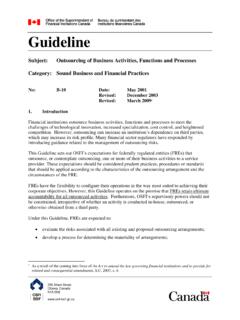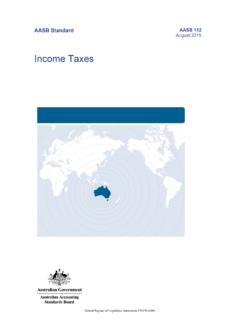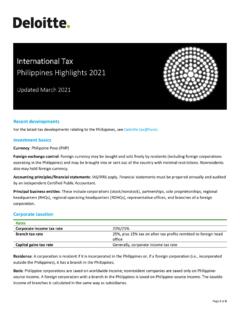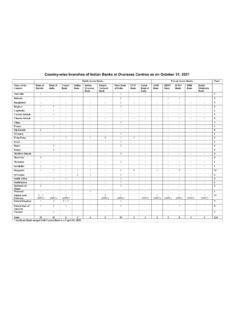Transcription of Definitions of Foreign Direct Investment (FDI): a ...
1 Definitions of Foreign Direct Investment (FDI): a methodological note 1. Maitena Duce 2. Banco de Espa a Final draft July 31, 2003. Executive Summary The main purpose of this note is to deal with methodological aspects related to Foreign Direct Investment (FDI) from the viewpoint of the Balance of Payments and the International Investment Position (IIP). Special attention is paid to the financial system both as a sector investing directly abroad (home perspective) and receiving Investment (host perspective). The note clarifies concepts such as Direct investor, Direct Investment enterprise (subsidiary, associate and branch) and describes the different sector breakdowns available and what they imply for financial sector FDI.
2 The main statistical sources for FDI are reviewed and the discrepancies are shown for total inward FDI flows and stocks both for emerging and industrial countries. Discrepancies appear much larger for stocks particularly for emerging countries. Some very general trends can be found from this data: First, even if FDI flows to emerging countries have grown, the bulk of them continue to be directed to industrial countries. Second, the large reduction in FDI flows to emerging countries in 2001 in the UNCTAD statistics is much milder in the IMF.
3 Statistics and is not perceived in the stock data. Total stocks, as well as the stock of FDI. received by industrial countries, seem to have reached a plateau in IMF statistics but not in the UNCTAD ones. As for the sector breakdown, and in particular financial sector FDI, no readably comparable and reliable enough - data is available on an international basis. Even in national statistics the sector breakdown might not correctly reflect the total amount of Foreign Direct Investment outflows from the financial system, particularly if the Investment is carried out by holding companies.
4 In the case of Spain, the re-estimation of outward FDI flows of the financial sector including the transactions carried out by resident holding companies, implies an increase of over 50% for the period 1997-2001. 1. Maitena Duce works at Banco de Espa a, in the International Economics and International Relations Department. For questions you can contact Comments have been received from Alicia Garc a Herrero from the same Department, and from Eduardo Rodr guez Ten s from the Balance of Payments Department. Spanish FDI data have been estimated by the Balance of Payments Department.
5 2. This note has been prepared as background material for the BIS Meeting of the CGFS Working Group on FDI in the financial sector, to be held on March 11. -1- 1. Introduction Foreign Direct Investment (FDI) from the viewpoint of the Balance of Payments and the International Investment Position (IIP) share a same conceptual framework given by the International Monetary Fund (IMF). The Balance of Payments is a statistical statement that systematically summarises, for a specific time span, the economic transactions of an economy with the rest of the world (transactions between residents and non-residents) and the IIP compiles for a specific date, such as the end of a year, the value of the stock of each financial asset and liability as defined in the standard components of the Balance of Payments.
6 We will not deal in this note with other relevant statistical concepts for operations overseas, particularly for financial institutions, such as exposure ( Foreign claims, international claims, etc.), which belong to the realm of the BIS Sections 2, 3 and 4 give an overview of FDI Definitions , concepts and recommendations adopted by the IMF's Balance of Payments Manual (5th Edition, 1993) and by the OECD's Benchmark Definition of Foreign Direct Investment (3rd Edition, 1996). Both provide operational guidance and detailed international standards for recording flows and stocks related to FDI.
7 Section 5 gives a quick overview of trends in FDI inward flows and stocks for the period 1980-2001. Section 6 reports on onward FDI flows for Spain, with particular attention to the financial sector. Finally a brief description of the main available sources of FDI is found in an annex. 2. What is Foreign Direct Investment (FDI). According to the IMF and OECD Definitions , Direct Investment reflects the aim of obtaining a lasting interest by a resident entity of one economy ( Direct investor) in an enterprise that is resident in another economy (the Direct Investment enterprise).
8 The lasting interest implies the existence of a long-term relationship between the Direct investor and the Direct Investment enterprise and a significant degree of influence on the management of the latter. Direct Investment involves both the initial transaction establishing the relationship between the investor and the enterprise and all subsequent capital transactions between them and among affiliated enterprises4, both incorporated and unincorporated. It should be noted that capital transactions which do not give rise to any settlement, an interchange of shares 3.
9 See Banco de Espa a's report Investing in the financial sector abroad: potential risks and how to mitigate them for some information on the statistics available to measure exposure. 4. Affiliated enterprises: enterprises that are in a Direct Investment relationship. -2- among affiliated companies, must also be recorded in the Balance of Payments and in the IIP. The fifth Edition of the IMF's Balance of Payment Manual defines the owner of 10% or more of a company's capital as a Direct investor. This guideline is not a fast rule, as it acknowledges that smaller percentage may entail a controlling interest in the company (and, conversely, that a share of more than 10% may not signify control).
10 But the IMF. recommends using this percentage as the basic dividing line between Direct Investment and portfolio Investment in the form of shareholdings. Thus, when a non-resident who previously had no equity in a resident enterprise purchases 10% or more of the shares of that enterprise from a resident, the price of equity holdings acquired should be recorded as Direct Investment . From this moment, any further capital transactions between these two companies should be recorded as a Direct Investment . When a non-resident holds less than 10% of the shares of an enterprise as portfolio Investment , and subsequently acquires additional shares resulting in a Direct Investment (10% of more), only the purchase of additional shares is recorded as Direct Investment in the Balance of Payments.















